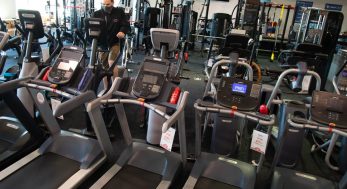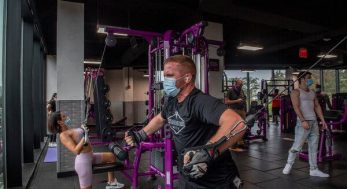NWI trainers: How to make everyday activities a foundation for fitness
Fitness takes many forms: A runner on a dirt trail, an athlete under an Olympic barbell, a boxer with a glove on a bag.
The list goes on.
Fitness measures that you might not immediately think of is a father unloading groceries, a commuter climbing a flight of stairs, or a truck driver stretching his legs after a long haul.
Everyday movements inform our fitness and our lives. Doing them with good biomechanics and posture can create good habits. Doing them poorly can make existing problems worse and take us further from our fitness goals.
“Those mundane (daily) activities should be viewed as investments in our health and fitness,” said Jason L. Clinton, a personal trainer at Franciscan Health Fitness Center in Schererville. “It may not be the sexiest thing in the world to take time out to stretch during our work hours, but it will pay dividends when you come home and still have pain-free energy for your significant other and/or kids.”
Seizing small moments for fitness could add up to big changes for many Americans. According to the U.S. Department of Health and Human Services official website, just one in three adults gets the recommended amount of weekly physical activity.
“When muscles are no longer in use, they slowly become weaker. Eventually, they begin to shrink,” Kim Terpstra said, a group exercise department supervisor and instructor at Community Hospital Fitness Pointe in Munster.
“If you are in a seated job, bedridden, or simply avoiding physical activity, you lose muscle tone primarily noticed in the arms, shoulders, abdominals, back and legs.”
Terpstra guides a class at Fitness Pointe known as FLEE, or Functional Living Exercises for Everyone. It addresses activities of daily living through motion, incorporating light resistance.
Terpstra said many FLEE attendees, who range from 50 to 90, comment on how much better they feel physically and mentally.
“They are more comfortable getting in and out of their cars, standing from a sitting position, utilizing stairs … their endurance improves, (they experience) less fatigue and feel more confident in their basic living skills,” Terpstra said.
Skipping the elevator is a great way to get one’s steps in for the day, but this can be even more beneficial with some guidance.
Clinton said the glute (buttocks) and hamstring (posterior thigh) muscles should be emphasized over the quads, the large muscle group on top of the thigh above the knee. To do this and reduce knee pain and pressure, push off from each step with your midfoot and heel instead of the forefoot, Clinton said.
“If you experience back pain when climbing stairs, it may be from leaning forward with your low back primarily,” Clinton said.
“We all typically have to lean forward when climbing stairs due to their placement but leaning should come from hinging at the hips and not bending at the low back.”
Bending and lifting even small loads can lead to injury with poor movement patterns, particularly in the low back.
Terpstra said to lift the right way, stand close to the load with feet placed shoulder width apart. Then, squat, bending at the hip and knees with the spine “neutral,” or in a balanced, straight position.
For picking up the item, the load should stay close to the body and be lifted slowly. Don’t twist while rising with the load, Terpstra added.
For those with long commutes or sedentary professions, small doses of movement help maintain better posture.
“Our bodies just feel and move better when we have good posture,” Clinton said. “You’ll benefit from being able to breathe better, and (you’ll) improve digestion and blood circulation.”
Clinton said in a sedentary environment at work or home, get up frequently to move or to stretch lightly to aid in blood circulation and promote better posture.
Driving long distances also demands breaks to offer key muscles relief. Clinton said to stretch the hip flexors, quads, and move the ankles at every stop.
Another threat to good posture stems from smartphone and tablet usage. Looking away from devices more often can help prevent a number of problems.
“Constantly looking down at our screens has negatively affected our neck posture, which then sends a cascade of compensatory issues down our body including pain, headaches, and inefficient breathing,” Clinton said.
Strength training can help ward off muscle loss from being sedentary, Terpstra said.
She recommended the Centers for Disease Control and Prevention guideline of training all the major muscle groups at least twice a week.
“Strength training improves your confidence. It helps you better perform simple daily activities from getting dressed to cleaning the kitchen,” Terpstra said.
Practicing daily activities with fitness in mind goes beyond correcting weaknesses and breaking bad habits.
“Use your muscles or lose your muscles. Find something to do that adds ‘fitness’ to your life — dancing, gardening, taking walks or something else that you enjoy doing,” Terpstra said.


